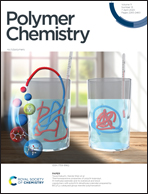Micro-block versus random quaternized poly(arylene ether sulfones) with highly dense quaternization units for anion exchange membranes†
Abstract
To investigate the effect of the segment architecture on membrane performance, a series of micro-block-type poly(ether sulfone)s with long hydrophilic segments were synthesized. Meanwhile, two other classes of polymers with random and intermediate construction were also synthesized. After optimized chloromethylation and quaternization reactions, respectively, the resulting AEMs were obtained with comparable IEC values. TTP-n-QAPES with the longest hydrophilic segment and the most intensive ion clustering produced the most distinct hydrophilic–hydrophobic phase morphology, which was confirmed by small-angle X-ray scattering (SAXS) and atomic force microscopy (AFM) observation. TTP-18.2-QAPES with an IEC of 2.17 meq g−1 showed a hydroxide conductivity of 64.5 mS cm−1 at 80 °C, which was almost 1.34 times higher than that of a random copolymer based AEM with the same IEC value, while preserving the promoted water management capacity and dimensional stability (about 20% lower than that of random type AEMs) due to the well-defined ion nanochannels. Moreover, TTP-n-QAPES was more stable than the corresponding random type AEMs under harsh basic conditions. A systematic study of long-term alkaline stability was performed, and SN2 nucleophilic substitution could be determined as the main degradation method by 1H NMR spectroscopy. Furthermore, the TTP-18.2-QAPES based MEA achieved a considerable power density of 148 mW cm−2 at 60 °C. These results suggest that the construction of long hydrophilic segments is a promising approach to promote the comprehensive performance of AEMs.



 Please wait while we load your content...
Please wait while we load your content...